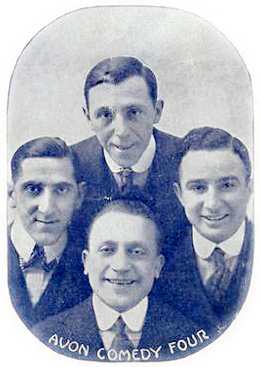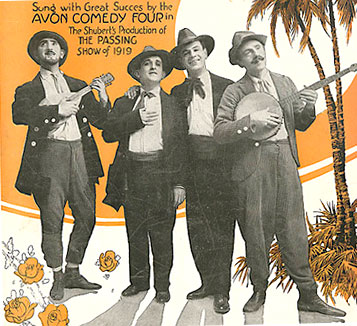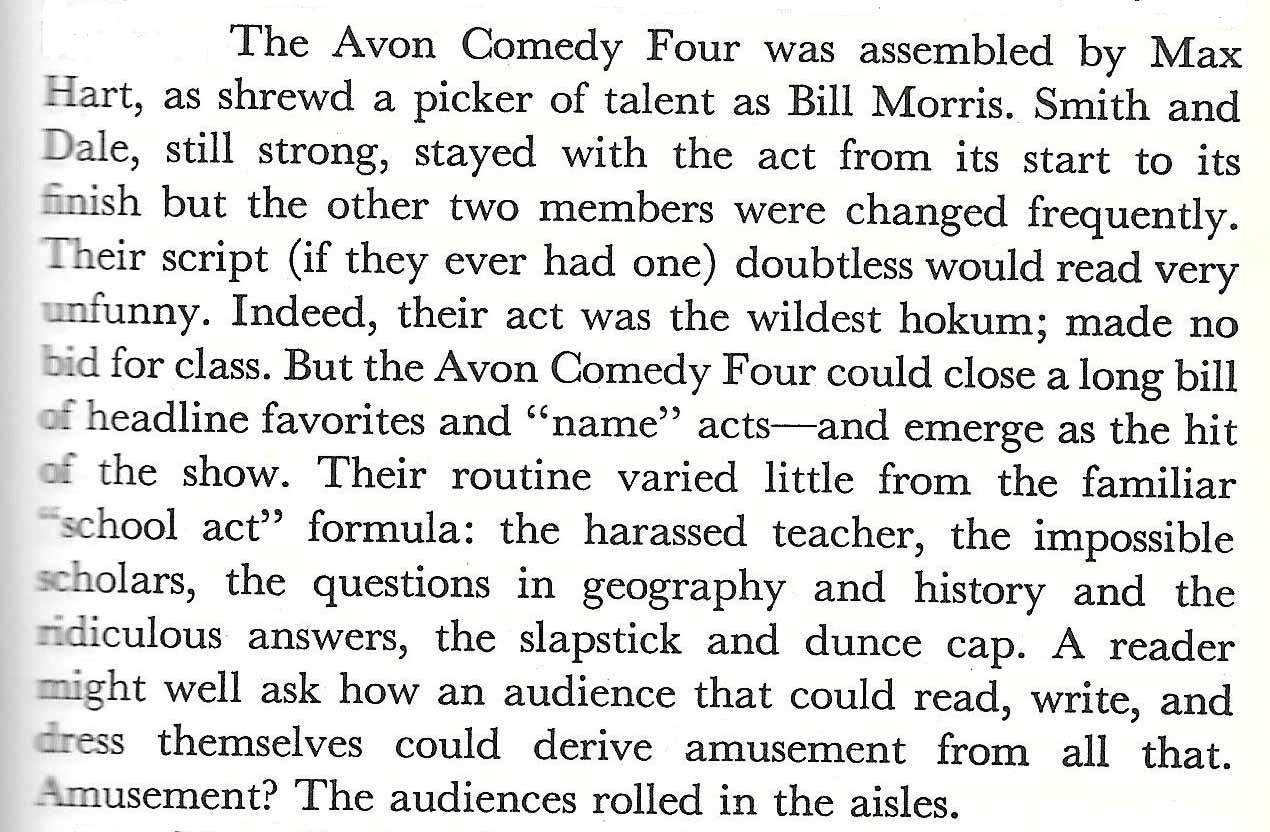Avon Comedy Four
singing comedians / 1900s
(from American Vaudeville Pioneers by Allan Sutton)
A New York Times report, published in 1918, offered a far less colorful version of the story. The Times did not mention
the bicycle incident, claiming instead that Smith and Dale were simply “boyhood chums on the East Side.” The story went
on to say that the team took to the road after having been rejected as an act by A. H. Woods, manager of the National
Theatre, and later their manager. They eventually landed in Kingston, New York. There, it was said, they rented
a piano and opened their own theater while working at a nearby icehouse to keep the venture solvent.

Neither account is accurate in claiming that Kaufman — who would have been 11 or 12 years old at the time — was
signed for the original act. Goodwin also seems to have arrived later than he recalled. The evidence is that the
initial personnel were Smith, Dale, Jack Coleman, and Will Lester.
By 1903, the Avon Comedy Four was appearing in much more reputable venues, touring on the F.F. Proctor
vaudeville circuits and playing many of New York’ higher-class houses. Among its most popular routines was the
“Hungarian Rhapsody” skit, which Smith later estimated he had performed 10,000 times. In the summer off-seasons the
quartet followed the crowds to the seashore, playing music halls and amusement piers at Coney Island, Brighton Beach,
Atlantic City, and other popularresorts. Although all members of the quartet were Jewish, they sometimes volunteered
at benefit performances for Protestant and Catholic parishes. Perhaps one of their oddest engagements was a Thanksgiving
Day concert for the prisoners on Blackwell’s Island. The Avon Comedy Four’s fame eventually even extended overseas.
In 1914 the quartet sailed to England to play a royal command performance at the Palace Theatre in London.
Smith and Dale’s comic routines had always been the Avon Comedy Four’s leading feature, but as their fame spread,
more emphasis was placed on the musical component of the act. At some point in the early 1910s, tenor Irving Kaufman was
brought in to handle the lead vocals. The date of Kaufman’s arrival has not been determined, but he appears in the
group’s photo on the sheet music of “Way Out Yonder in the Golden West,” a 1914 publication. He was clearly present on
June 7, 1916, when the quartet recorded its first sides — “Yaaka Hula Hickey Doola” and “My Mother’s Rosary” (Victor 18081)
— under Rosario Bourdon’s direction in Camden, New Jersey.
Victor seems to have little interest in Smith and Dale’s comic routines. Several were recorded, but only
“The Professor's Birthday” and “Ginsberg’s Stump Speech” were issued, coupled on Victor 35606. The remainder of
the group’s 1916 Victor output consisted of close-harmony quartet singing, capably led by Kaufman.
Victor let the group go at the end of 1916, and they moved to Emerson, which issued several of their vocal recordings
on 6” and 7” discs in April 1917. They then returned to Victor briefly, cutting three rejected sides in August 1917,
before signing with Columbia the following month. Columbia issued only sides between 1917 and 1919, all of them
straightforward vocals.
While the Avon Comedy Four were having little luck in the recording studios, the act was increasingly successful
on Broadway. In 1918, under the management of A. H. Woods—the same man who had rejected Smith and Dale in the 1890s —
the group made its first appearance in a major Broadway musical, starring with Fannie Brice in Why Worry?
The show opened at the Harris Theatre on August 23, 1918, and ran for only 27 performances, but it established the
Avon Comedy Four as something more than just a vaudeville act. The quartet was next signed to appear in the
prestigious Passing Show of 1919, but fate intervened. An actor’s strike was called in August 1919, shortly
before the show was scheduled to open, and Smith and Dale withdrew the act in support of the strikers. When the strike
ended and the show opened in October 1919 the Avon Comedy Four were back on the bill, but both Kaufman and Goodwin
were conspicuously absent from the new publicity shots. In their place were E. Rash and Charles Adams.

Smith and Dale managed to keep the Avon Comedy Four afloat into the late 1920s, traveling the Keith vaudeville circuits
and landing radio jobs in lieu of recording contracts, but by 1930 they had tired of the routine. In April 1930 the Times
reported that both were “eager to put aside their old Avon Comedy Four act and display themselves in what is
euphemistically called ‘the legitimate.’” Smith and Dale disbanded the quartet and invested heavily in an ill-fated
production entitled Mendel, Inc.
The failure of Mendel, Inc., would prove only a temporary setback for the team. Smith and Dale would go
--------------------------------------------------------------------------------
The complete Avon Comedy Four discography can be found in the author’s American Stage Performers Discography —
--------------------------------------------------------------------------------
NOTES
- By 1902 they joined two singing comedians, Irving Kaufman (later a popular singer) and Harry Godwin in a team known as "The Avon Comedy Four". The act became one of the most successful comedy turns in vaudeville. For over 15 years they were top-of-the-bill performers on Broadway and appeared in a 1916 show, Why Worry? The foursome made commercial recordings replicating their stage act, as in a 1917 restaurant sketch:
SMITH: "One cheese sandwich! The cheese should be neutral."
SMITH: "Where's the manager?"
- By 1919, the act had run its course, and the Avon Comedy Four broke up. Smith and Dale took up where the foursome left off, playing Broadway and vaudeville (including the Palace Theatre, considered the pinnacle of stage venues). Both used a heavy Jewish dialect, with Smith speaking in a deep, pessimistic voice and Dale in a high, wheedling tenor.
Listings only:
Actors, Vaudevillians, and Musical Comedy Stars, available from Mainspring Press.
1. “Biographical Note,” in Guide to the Smith and Dale Papers, 1903–1981. New York Public Library for the Performing Arts (2006).
2. “Minute Visits in the Wings.” New York Times (9/1/1918), p. 36.
3. “Harry Goodwin, 62, of Avon Quartet [sic]” [obituary]. New York Times (10/26/1942), p. 15.
4. See, for example, Kilgarriff: Grace, Beauty and Banjos (Oberon Books, 1999).
5. “Vaudeville for Prisoners.” New York Times (11/21/1921), p. 23.
6. Goodwin obituary, op. cit.
7. The Avon Comedy Four’s complete discography appears in the author’s American Stage Performers Discography—Actors, Vaudevillians, and Musical Comedy Stars (Mainspring Press), scheduled to release in 2007.
8. Norton, Richard A. Chronology of the American Musical Theater, Vol. II, p. 158. New York: Oxford University Press (2002).
9. “Striking Actors Sued for $500,000 by the Shuberts.” New York Times (8/12/1919), p. 1
10. Goodwin stated that he left the group in 1922, but given the many other demonstrable errors in his account, this is probably incorrect. Rush and Adams are named on the Passing Show showbills. Kaufman and Goodwin are both credited on the 1918 playbill for Why Worry?
11. “In the ‘Abie’ Tradition.” New York Times (4/6/1930), p. 122.
from "Smith & Dale":
DALE: "One sandwich, with American cheese."
DALE: "He's not here, he went across the street to a good restaurant."
New York Times: June 23, 1907 (Keith & Protor's 58th Street Theatre) - New York Times: April 4, 1909 (Hammerstein's Victoria, "in skit, 'The New Teacher")

from American Vaudeville: Its Life and Times
by Douglas Gilbert (1940 - pg303)
-
Return to Vaudeville Acts Index